Fix: Steam Library Folder not Writable
The default location for new Steam games is located at the same folder where you decided to install Steam in and that is usually in Program Files >> Steam >> SteamApps >> Common. However, certain problems begin to appear if you try and create a new library for Steam games, especially if that library is located on an external SSD or HDD drive.
This problem does not appear exclusively in this scenario and there are many different causes for it. Still, you can follow some of the methods below to try and solve the problem quite easily!
Solution 1: Make Sure the Folder is not Read-Only
If the problem occurs during an installation or the updating process of a Steam game, you might as well try and navigate to your library folder and check to see if the folder has the read-only properly turned on. If it does, try turning it off and check to see if that actually solves the problem.
- First of all, let’s clear the downloading process in order to restart it. Close your Steam client completely by right-clicking its icon at the system tray and choosing the Exit option.
- Navigate to the C >> Program Files >> Steam >> SteamApps >> downloading folder and delete the numbered folder corresponding to the problematic game. You can find that number here by searching for your game and checking the AppID number next to it.
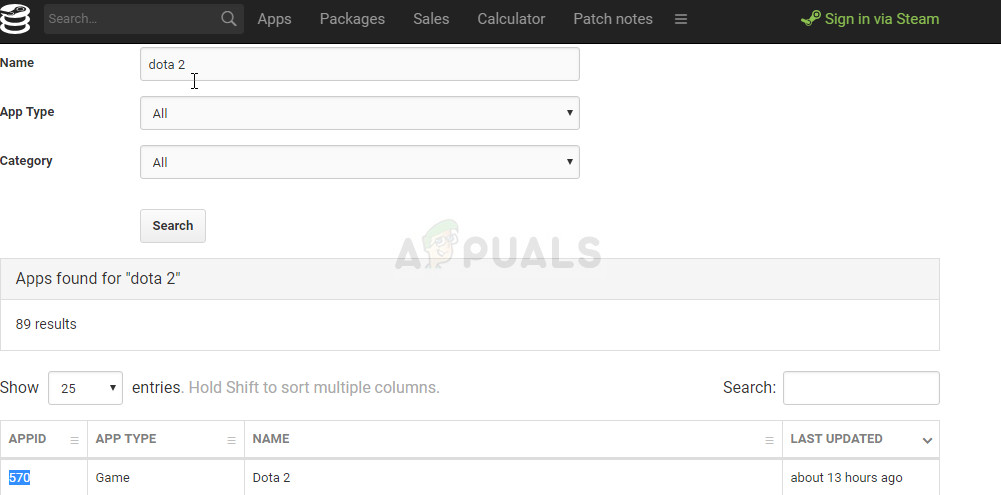
- If the folder can’t be deleted, you may need to take ownership of it. Right-click the folder, click Properties, and then click the Security tab. Click the Advanced button. The “Advanced Security Settings” window will appear. Here you need to change the Owner of the key.
- Click the Change link next to the “Owner:” label The Select User or Group window will appear.
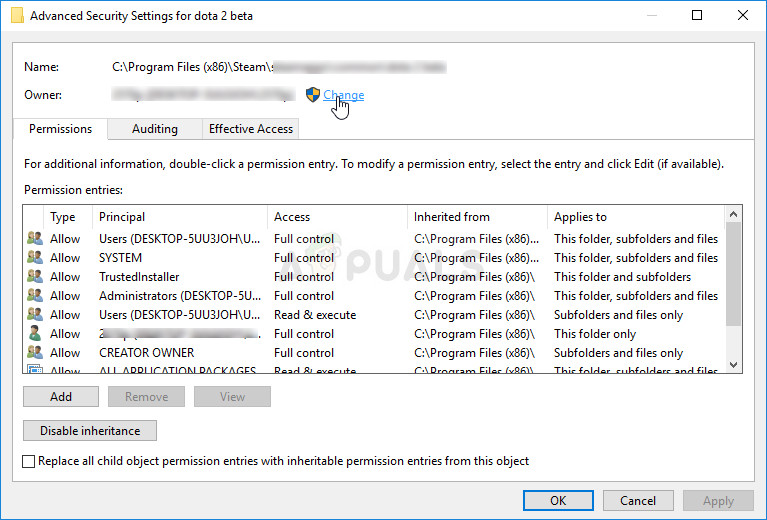
- Select the user account via the Advanced button or just type your user account in the area which says ‘Enter the object name to select’ and click OK. Add your user account.
- Optionally, to change the owner of all subfolders and files inside the folder, select the check box “Replace owner on subcontainers and objects” in the “Advanced Security Settings” window. Click OK to change the ownership. Try deleting it afterwards.
After this, we will try to remove the read-only property from the library folder you are using at that helped most users solve their problem immediately.
- Locate the library folder where your games should install and download. The usual location is C >> Program Files >> Steam >> SteamApps. However, the error usually appears with user-added folders so make sure you navigate to it.
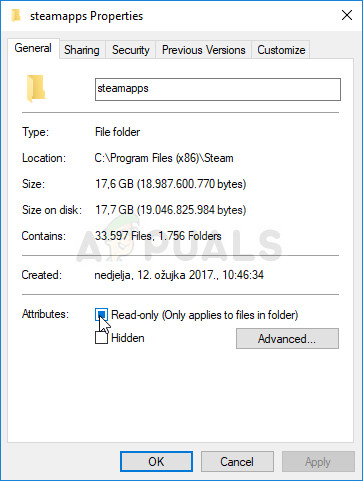
- Right-click on the problematic folder and click the Properties option from the context menu. Stay in the General tab and locate the Attributes section at the bottom. Clear the box next to the Read-only option and click on Apply before exiting. Check to see if the problem still appears.
Solution 2: Reinstall the Problematic Game
If the problem appears during an update for an existing game on your computer and if the problem didn’t appear before for the same game and for the same folder, it might just be a bug which can be fixed by reinstalling the game.
It’s an easy, but time-consuming process because of the fact that you will have to redownload the game files. The good thing is that you won’t lose any of your progress as it’s linked to your Steam account.
- First of all, make sure you are logged in with an administrator account as you won’t be able to delete programs using any other account.
- Make sure your files are backed up using Steam Cloud in order to make sure you don’t lose your in-game progress.
- Click on the Start menu and open Control Panel by searching for it. Alternatively, you can click on the gear icon in order to open settings if you are using Windows 10.
- In Control Panel, select to View as: Category at the top right corner and click on Uninstall a Program under the Programs section.
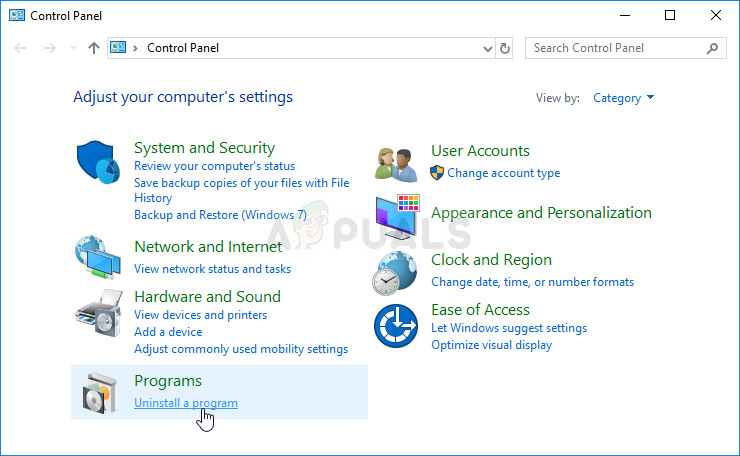
- If you are using the Settings app on Windows 10, clicking on Apps should immediately open a list of all installed programs on your PC.
- Locate the problematic game in Control Panel or Settings and click on Uninstall.
- Steam client should launch after a while and ask you to confirm your choice and delete the game files from your computer. Make sure you confirm your choice and stay patient for the process to finish.
- Reinstall the game by navigating to the Library area of your Steam client and locating your game from the list at the left side of the window. Right-click on the game and choose the Install game option. It should start the downloading and installing process immediately. Check to see if you still receive the same error.
Solution 3: Perform a Folder Fix from the Client
The Steam client actually has a method to fix the current library folder easily and this feature has proven itself useful even when dealing with these errors. There are plenty of users who claim that this simple method has managed to solve their problem after the solutions above have failed so make sure you try it out!
- Open your Steam client by double-clicking its icon on the Desktop or by searching for it in the Start menu and clicking on the first result.
- Click on the Steam option at the menu at the top of the client’s window and choose Settings. In the Settings window navigate to the Downloads tab and click on the Steam library folders button at the top of the window.
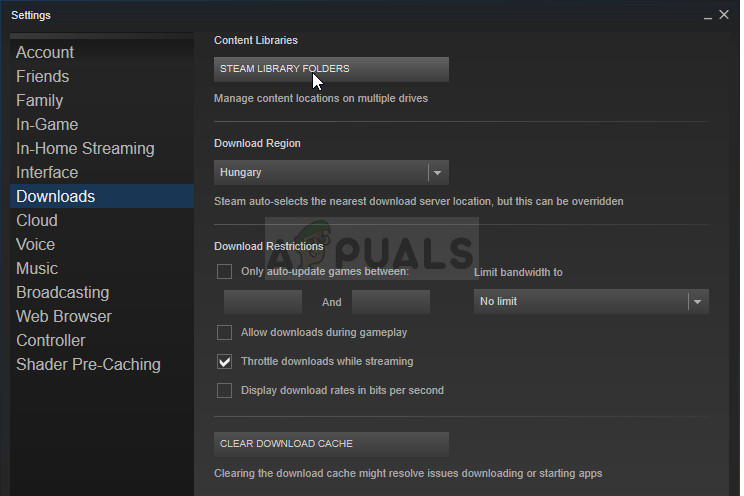
- Locate the folder where your problematic game is located. You should be able to see the default library folder (C >> Program Files >> Steam) as well as all folders you have added manually. Choose the one you want to fix, right-click on it and choose the Repair Library Folder option.
- Confirm any UAC prompts and you should see a Steam Client Service window open with a “Command-Prompt-like” interface. Wait for a while in order to repair the folder- It should close on its own so check to see if your problem is solved afterwards.
Solution 4: Use a Folder Other Than Program Files
If the Program Files folder on your computer has become write-protected in a way, you might want to change the default library folder on your computer and set it to a new one, hopefully solving the problem you are facing. Good luck!
- Create a folder anywhere you want. That folder is where the problematic game will be downloaded so make sure there is plenty of space at that specific location. Make sure you disable its read-only property just like in Solution 2, the second part.
- Right-click on your Steam client either on the Desktop or in Start menu and choose Run as administrator.
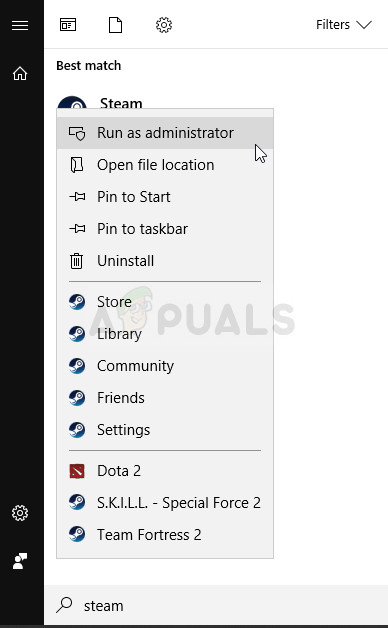
- After that, click on the Steam option at the menu at the top of the client’s window and choose Settings. In the Settings window navigate to the Downloads tab and click on the Steam library folders button at the top of the window.
- Click on Add Library Folder and select the folder you have created in the step 1 of this solution. Now, every time you try and download and install a game, you will be prompted by a choice of where to install.
- Uninstall the game by navigating to the Library tab in the Steam client, locating your game in the list at the left side of the window, right-clicking on it, and choosing the Uninstall option.
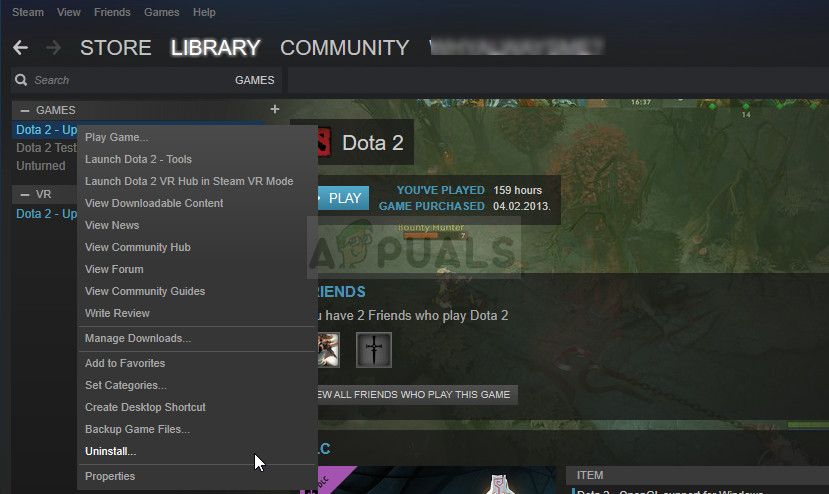
- Try to install it again from Library and make sure you select the new folder for the installation. Right-click on the game in the Library and choose Install. Check to see if the problem is gone.
Solution 5: Restart Your Computer
This may look like the simplistic solution which never actually works but there are plenty of users who simply didn’t think restarting the computer will solve it but it did, eventually. Make sure you restart your computer often enough as there are bugs which appear when the system has been running for too long and restarting it sort of fixes this issue.
Click on the Start menu and click the power button. Choose Restart and wait for your computer to boot again. Check to see if the problem is gone now.
Solution 6: Check Your Drive for Errors
If the problem is not directly linked to Steam issues, it may be your hard drive corruption which is causing the issue or there might have been some bugs which can be solved easily. Either way, there is a simple way you can run a scan for errors on your hard drive (or any other storage device where your games might be located). This has helped several users and it’s very easy to do it!
- Open This PC or My Computer depending on the version of Windows you have installed. You can get there by opening your Windows Explorer interface and clicking on This PC/My Computer at the left side navigation pane.
- Right-click on the drive where your problematic game is located and choose the Properties option. In the Properties window, navigate to the Tools tab and click on Check under the Error checking section.
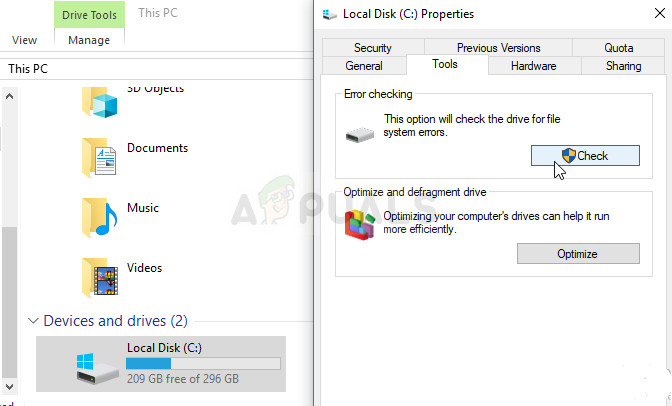
- Follow the instructions on screen in order to progress and be patient for the tool to scan your hard drive as it will definitely take a while. Restart your computer afterwards and check to see if the problem is gone.
Solution 7: Make Sure You Add Steam to Antivirus’ Exceptions
Antivirus tools should not disturb the operations of normal, trustworthy programs such as Steam but they sometimes do that and that is a fact that has been going on for years now. This often occurs with free antivirus tools such as Avast or AVG but the problem can be resolved simply by adding Steam to the exceptions list, without needing to uninstall or change the antivirus you are using.
- Open the antivirus user interface by double-clicking on its icon at the system tray (right part of the taskbar at the bottom of the window) or by searching for it in the Start menu.
- The Exceptions or Exclusions setting is located in different spots with respect to different antivirus tools. It can often be found simply without much hassle but here are some quick guides on how to find it in the most popular antivirus tools:
Kaspersky Internet Security: Home >> Settings >> Additional >> Threats and Exclusions >> Exclusions >> Specify Trusted Applications >> Add.
AVG: Home >> Settings >> Components >> Web Shield >> Exceptions.
Avast: Home >> Settings >> General >> Exclusions.
- You will need to add Steam’s main executable file in the box which will appear prompting you to navigate to the file. It should be in the same directory where you installed it (C >> Program Files >> Steam >> Steam.exe is the usually location). If you have a shortcut on the desktop, right-click on it and choose Open file location.
- Check to see if you are now able to open the file. If it still won’t work, try restarting your computer and try again.
Solution 8: Take Ownership of the Folder and Give Write Permissions
If the error says that the folder is not writeable, it’ quite possible that you don’t have the sufficient permissions to write and read from that folder. This can occur because of a variety of different reasons and it’s quite straightforward to fix it if you have the patience.
- Right-click the library folder you are using, click Properties, and then click the Security tab. Click the Advanced button. The “Advanced Security Settings” window will appear. Here you need to change the Owner of the key.
- Click the Change link next to the “Owner:” label The Select User or Group window will appear.

- Select the user account via the Advanced button Add your user account.
- Optionally, to change the owner of all subfolders and files inside the folder, select the check box “Replace owner on subcontainers and objects” in the “Advanced Security Settings” window. Click OK to change the ownership.
- In the Security tab of the library folder’s Properties window, click on Edit in order to change permissions and select your personal user account you set the ownership to. Change permissions to Full Control and apply the changes. Check to see if the problem occurs anymore.
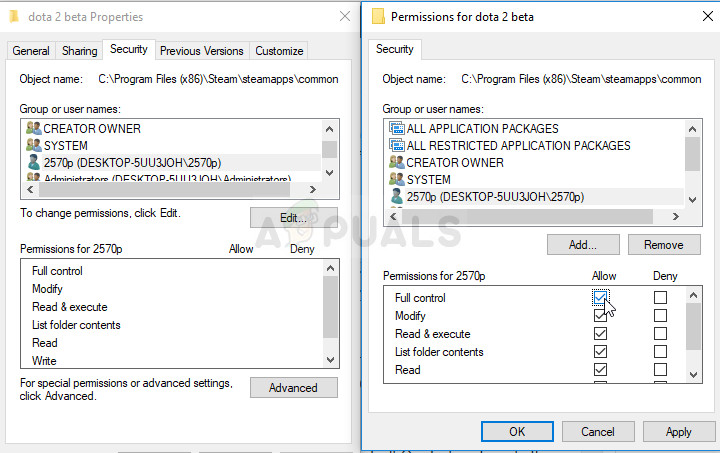
The post Fix: Steam Library Folder not Writable appeared first on Appuals.com.





No comments